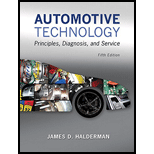
Automotive Technology: Principles, Diagnosis, and Service Plus MyLab Automotive with Pearson eText -- Access Card Package (5th Edition) (Automotive Comprehensive Books)
5th Edition
ISBN: 9780134009087
Author: James D. Halderman
Publisher: PEARSON
expand_more
expand_more
format_list_bulleted
Concept explainers
Textbook Question
Chapter 28, Problem 1CQ
A short block includes the __________.
- a. block
- b. crankshaft and main bearings
- c. pistons, rods, and rod bearings
- d. All of the above
Expert Solution & Answer
Want to see the full answer?
Check out a sample textbook solution
Students have asked these similar questions
1) Consider the robot, with six degrees of freedom, RRPRR, shown in the following figure.Place the axes through the denavit-hartenberg algorithm and obtain the respective parameter table for the first three joints. 2) Considering the robot from question 1, calculate.the. Determine the Homogeneous Transformation Matrix in relation to the Direct Kinematics of the robot, for the first three joints:b. Considering the first three joints of the robot and L1 and L2 equal to 200 mm:I. calculate the pose of the robot relative to the base, knowing the joint variableshave the following values: q1= 90°, q2= 0°, q3= 50mm:
Please do not rely too much on chatgpt, because its answer may be wrong. Please consider it carefully and give your own answer. You can borrow ideas from gpt, but please do not believe its answer.Very very grateful!
Please do not copy other's work,i will be very very grateful!!
Don't use Artificial intelligence
Chapter 28 Solutions
Automotive Technology: Principles, Diagnosis, and Service Plus MyLab Automotive with Pearson eText -- Access Card Package (5th Edition) (Automotive Comprehensive Books)
Ch. 28 - What are the differences between a minor and a...Ch. 28 - When should the factory-installed lifting hooks be...Ch. 28 - Why should the cylinder bore be measured before...Ch. 28 - Prob. 4RQCh. 28 - Prob. 5RQCh. 28 - A short block includes the __________. a. block b....Ch. 28 - When removing cylinder heads, the fasteners should...Ch. 28 - Prob. 3CQCh. 28 - What needs to be removed before the valves can be...Ch. 28 - With the rocker cover (valve cover) removed, the...
Additional Engineering Textbook Solutions
Find more solutions based on key concepts
What is an uninitialized variable?
Starting Out with Programming Logic and Design (5th Edition) (What's New in Computer Science)
17–1C A high-speed aircraft is cruising in still air. How does the temperature of air at the nose of the aircra...
Thermodynamics: An Engineering Approach
Why is the study of database technology important?
Database Concepts (8th Edition)
How are relationships between tables expressed in a relational database?
Modern Database Management
The following C++ program will not compile because the lines have been mixed up. cout Success\n; cout Success...
Starting Out with C++ from Control Structures to Objects (9th Edition)
Porter’s competitive forces model: The model is used to provide a general view about the firms, the competitors...
Management Information Systems: Managing The Digital Firm (16th Edition)
Knowledge Booster
Learn more about
Need a deep-dive on the concept behind this application? Look no further. Learn more about this topic, mechanical-engineering and related others by exploring similar questions and additional content below.Similar questions
- Solve this problem and show all of the workarrow_forwardI need to calculate Fdy, Fby, Fbxarrow_forwardFigure 3 shows the numerical solution of the advection equation for a scalar u along x at three consecutive timesteps. 1.0- 0.8- 0.6- 0.4- 0.2 0.0- -0.2- -0.4- -0.6 T T T 3.0 3.5 4.0 4.5 5.0 5.5 6.0 6.5 Figure 3: Advection equation, solution for three different timesteps. a) Provide an explanation what conditions and numerical setup could explain the curves. Identify which of the three curves is the first, second and third timestep.arrow_forward
- please solve the following problemarrow_forwardA 5 cm external diameter, 10 m long hot water pipe at 80 degrees C is losing heat to the surrounding air at 5 degrees C by natural convestion with a heat transfer coefficient of 25 W/m^2 K. Determine the rate of heat loss from the pipe by natural convection.arrow_forwardThe outer surface of a spacecraft in space has emissivity of 0.8 and a solar absorptivity of 0.3. If solar radiation in incident on the spacecraft at a rate of 950 W/m^2, determine the surface temp of the spacecraft when the radiation emitted equals the solar energy absorbed.arrow_forward
- Of the following pairs of material types, indicate whether any of them satisfy the condition that both elements of the pair are generically related to the property of ductility.(A). Yes, ceramics and polymers.(B). No, none of the pairs.(C). Yes, metals and ceramics.(D). Yes, polymers and metals.arrow_forwardBoth Fouriers law of heat conduction and ficks law of mass diffusion can be expressed as Q=-kA(dT/dx). What do the quantities Q, k, a and T represent in a) heat conduction b)mass diffusionarrow_forward(9) Figure Q9 shows a 2 m long symmetric I beam where the upper and lower sections are 2X wide and the middle section is X wide, where X is 31 mm. The I beam sections are all Y=33 mm in depth. The beam is loaded in the middle with a load of Z=39 kN causing reaction forces at either end of the beam's supports. What is the maximum (positive) bending stress experienced in the beam in terms of mega-Pascals? State your answer to the nearest whole number. Y mm Y mm Y mm Xmm 2X mm Figure Q9 Z KN 2 marrow_forward
arrow_back_ios
SEE MORE QUESTIONS
arrow_forward_ios
Recommended textbooks for you
 Automotive Technology: A Systems Approach (MindTa...Mechanical EngineeringISBN:9781133612315Author:Jack Erjavec, Rob ThompsonPublisher:Cengage Learning
Automotive Technology: A Systems Approach (MindTa...Mechanical EngineeringISBN:9781133612315Author:Jack Erjavec, Rob ThompsonPublisher:Cengage Learning Automotive TechnologyMechanical EngineeringISBN:9781337794213Author:ERJAVEC, Jack.Publisher:Cengage,
Automotive TechnologyMechanical EngineeringISBN:9781337794213Author:ERJAVEC, Jack.Publisher:Cengage,

Automotive Technology: A Systems Approach (MindTa...
Mechanical Engineering
ISBN:9781133612315
Author:Jack Erjavec, Rob Thompson
Publisher:Cengage Learning

Automotive Technology
Mechanical Engineering
ISBN:9781337794213
Author:ERJAVEC, Jack.
Publisher:Cengage,
Dynamics - Lesson 1: Introduction and Constant Acceleration Equations; Author: Jeff Hanson;https://www.youtube.com/watch?v=7aMiZ3b0Ieg;License: Standard YouTube License, CC-BY